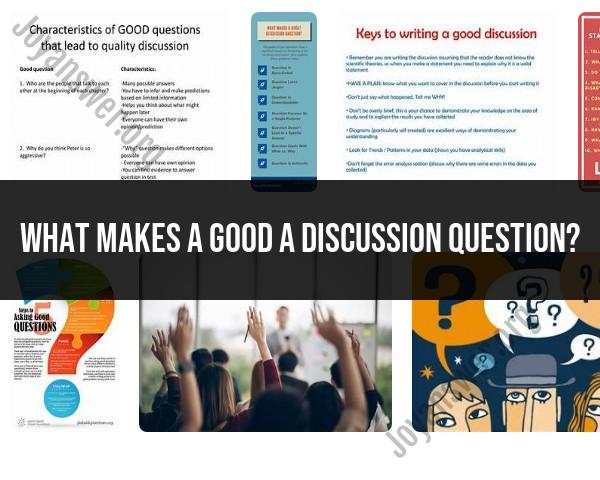What makes a good a discussion question?
A stimulating discussion question is one that encourages thoughtful reflection, fosters meaningful conversation, and engages participants in a dynamic exchange of ideas. Here are some characteristics of a good discussion question:
Open-Ended Nature:
- The question should be open-ended, allowing for multiple perspectives and interpretations. This encourages participants to explore different angles and express their opinions.
Relevance:
- The question should be relevant to the context, audience, or subject matter. A question that directly relates to the participants' experiences or interests is more likely to stimulate engagement.
Complexity:
- A good discussion question should be sufficiently complex to provoke critical thinking. It should go beyond simple yes/no answers and invite participants to analyze, evaluate, and synthesize information.
Connection to Real-World Examples:
- Connecting the question to real-world examples or scenarios makes it more tangible and relatable. This can help participants draw from personal experiences and apply their insights to practical situations.
Ethical Considerations:
- Questions that involve ethical dilemmas or moral considerations often stimulate rich discussions. Ethical questions prompt participants to reflect on their values and consider the implications of various choices.
Controversial or Debatable:
- A good discussion question may touch on controversial or debatable topics. Controversy often sparks interest and encourages participants to defend their perspectives, fostering a more dynamic discussion.
Multidisciplinary Approach:
- Questions that invite participants to draw from multiple disciplines or perspectives can enrich the discussion. This interdisciplinary approach encourages a diverse range of insights.
Clarity:
- While the question should be open-ended, it should also be clear and concise. Ambiguity in a question may lead to confusion rather than stimulating discussion.
Personal Relevance:
- Including elements that resonate with participants personally can enhance engagement. Questions that allow individuals to connect the topic to their own lives or experiences often lead to more meaningful discussions.
Novelty:
- Introducing a novel or unexpected element in the question can capture participants' attention. This might involve presenting a unique perspective, a surprising fact, or an unconventional scenario.
Encourages Active Participation:
- A good discussion question should prompt participants to actively contribute to the conversation rather than passively consume information. It should invite personal reflections, opinions, and experiences.
Balance:
- Striking a balance between being challenging and approachable is important. The question should not be so difficult that it discourages participation, nor should it be overly simplistic.
Promotes Inclusivity:
- Consider the diversity of your audience and aim for questions that are inclusive, respecting various backgrounds, experiences, and viewpoints. This promotes a more enriching and respectful discussion environment.
Time Considerations:
- Ensure that the question is appropriate for the available time. If the discussion is part of a larger conversation or workshop, the question should be manageable within the allotted timeframe.
By incorporating these characteristics into your discussion questions, you can create an environment that stimulates thoughtful conversation, encourages active participation, and allows for the exploration of diverse perspectives.
How do you craft discussion questions that encourage diverse perspectives?
Crafting discussion questions that encourage diverse perspectives is an art form. Here are some key tips to get you started:
1. Frame open-ended questions: Ditch the yes/no or fill-in-the-blank questions. Instead, use "wh" questions like "why," "how," "what if," and "what are the implications of..." This prompts deeper thought and allows for a wider range of viewpoints.
2. Avoid leading questions: Don't phrase your questions to nudge people towards a specific answer. Let the question stand on its own and invite independent thinking.
3. Challenge assumptions: Encourage critical thinking by asking questions that challenge dominant narratives or viewpoints. This could involve asking about alternative solutions, potential biases, or unintended consequences.
4. Invite personal and lived experiences: Frame questions that invite participants to share their own experiences and perspectives relevant to the topic. This fosters empathy and understanding of diverse viewpoints.
5. Use "what if" scenarios: Hypothetical scenarios can be a great way to explore different possibilities and consider how different people might react or be affected. This can spark creative thinking and open up new avenues for discussion.
6. Focus on understanding, not judging: Emphasize the value of different perspectives and encourage listening with an open mind. Avoid phrases like "you're wrong" or "that's not the right way to think."
7. Be mindful of power dynamics: Be aware of the power dynamics within your group and create a safe space for everyone to share their thoughts without fear of judgment or criticism. This might involve setting ground rules, actively inviting quieter voices to participate, and addressing any dominance issues.
8. Use visuals and prompts: Sometimes, a picture is worth a thousand words. Utilize visual aids, case studies, or thought-provoking quotes to spark discussion and encourage different interpretations.
9. Follow up and connect: Don't let the discussion end in the air. Actively listen to diverse perspectives, summarize key points, and connect them to the main topic. This helps everyone learn from each other and ensures everyone's voice is heard.
10. Continuously learn and adapt: Reflect on your own biases and be open to feedback. As you practice crafting discussion questions, keep learning from your experiences and adapt your approach to better encourage diverse perspectives and foster meaningful dialogue.
Remember, the key is to create a safe and inclusive environment where everyone feels comfortable sharing their unique perspective. By crafting thoughtful questions and actively listening to diverse voices, you can lead rich and engaging discussions that benefit everyone involved.


